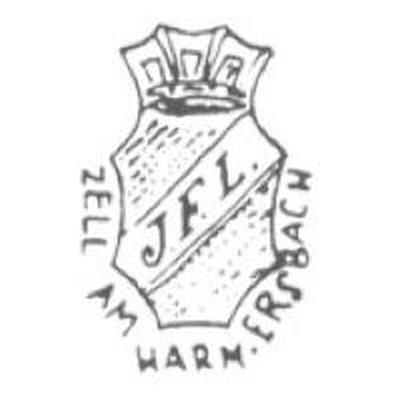
Image 010110-02-01
Used between 1846 and 1867 on porcelain only, the initials "JFL" stand for Jakob Ferdinand Lenz.
The origins of the factory in Zell can be traced back to October 22nd 1794, when Josef Anton Burger established an earthenware factory in that location. His products were an instant success and in 1802, the businessman Jakob Ferdinand Lenz from Lahr joined Burger as partner. Lenz was quite wealthy and had lived in England for a few years where he had gathered ideas for high-quality stoneware and fajence products. In 1805, he also convinced two other wealthy businessmen from Lahr to invest in the company. So Georg Schnitzler and David Knoderer joined as partners; the financial boost allowed the factory to expand and try out new ideas, mainly based on former ideas from Burger. Already in 1809 at first Knoderer and then Schnitzler decided to quit company; the two remaining partners continued business until Burger retired in 1819, leaving the factory to Jakob Ferdinand Lenz who kept the company name.
There is a very special porcelain set on display at the local museum in Zell today: shortly before the partner Georg Schnitzler left the company, he had two special porcelain sets made: one in white/green and one in white/blue. Both were heavily gilded, laid out for sixty people and were part of the dowry for his two daughters. Both sisters eventually died and one of their sons inherited both sets and later emigrated to New York. Shortly after World War II, the white/green set came back to Germany as part of the heritage for the Schnitzler relatives in Freiburg. Günter Haiss, the former manager of the Vereinigte Zeller Fabriken, heard of the heritage and convinced the family to donate the set to the local museum where it is displayed as an unique example of the porcelain tradition in Zell.
When Jakob Ferdinand Lenz passed the factory into the hands of his nephews, Gottfried Ferdinand Lenz and Wilhelm Schnitzler, the factor was renamed after him. By the middle of the 19th century, the demand for stoneware in Germany stagnated and shifted to porcelain, therefore half of the capacity had been switched to porcelain production as early as 1842, using kaolin that was transported by horse and cart from the famous Limoges area in France. The effort in producing porcelain was finally rewarded in 1846; the resulting pieces were so good that the Grand Duke rewarded the factory with a gold medal during the festivities at Karlsruhe castle, this resulted in a business increase for the whole area. Nonetheless Wilhelm Schnitzler quit the company in 1860, leaving Gottfried Ferdinand Lenz as sole proprietor.
The factory eventually ended up in the hands of Bruno Prössel who tried to continue business under a slightly altered name. He was however not very successful and already forced into foreclosure after a few years.
After belonging to Lenz for some time the factory was taken over by the aging businessman Carl Schaaff who started business in 1807 and was by now leaving the company in the hands of a board of directors who continued leading the company. In 1899, both this factory as well as the Steingut- und Porzellanfabrik Georg Schmider were slightly damaged by a massive fire that broke out in the middle of the town. Just as the townsfolk had managed to repair most damage another blaze in 1904 damaged both factories yet again, this time nearly forcing the directors to quit and file for bankruptcy. They managed to continue until 1907 and then finally accepted when Georg Schmider offered to take over the factory.

Image 010110-02-01
Used between 1846 and 1867 on porcelain only, the initials "JFL" stand for Jakob Ferdinand Lenz.
© 2004-2025 C.S.Marshall, all rights reserved